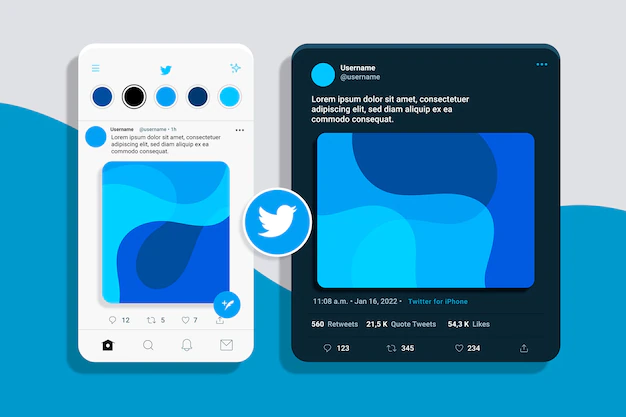In today’s digital age, social media is an integral part of any business’s marketing strategy. Social media platforms like Facebook, Twitter, and Instagram allow businesses to connect with their audience, build brand awareness, and drive traffic to their website. In this blog post, we will discuss the importance of integrating social media into your McKinney website design and provide some tips for doing so effectively.
Why Integrate Social Media into Your McKinney Website Design?
Build Brand Awareness Integrating social media into your McKinney website design can help you build brand awareness. By including social media icons on your website, you are providing visitors with an easy way to connect with your business on social media platforms. This can help increase your social media following and expose your brand to a wider audience.
Drive Traffic to Your Website
Social media can be a powerful tool for driving traffic to your website. By sharing links to your website on social media platforms, you are providing your audience with a direct path to your website. This can help increase website traffic and improve your website’s search engine ranking.
Improve User Engagement
Social media can also help improve user engagement on your website. By embedding social media feeds on your website, you can provide visitors with a more interactive experience. This can help keep visitors on your website for longer periods, increase user engagement, and improve your website’s overall user experience.
Tips for Integrating Social Media into Your McKinney Website Design
- Choose the Right Social Media Platforms
When integrating social media into your McKinney website design, it is important to choose the right social media platforms. Consider your target audience and the social media platforms they are most likely to use. For example, if your target audience is primarily millennials, you may want to focus on platforms like Instagram and Snapchat. If your target audience is professionals, you may want to focus on platforms like LinkedIn.
- Include Social Media Icons on Your Website
Including social media icons on your website is an easy way to integrate social media into your McKinney website design. Place the icons in a prominent location, such as the header or footer of your website, to make them easy to find. Make sure the icons are clickable and linked to your social media profiles.
- Embed Social Media Feeds
Embedding social media feeds on your website is another effective way to integrate social media into your McKinney website design. This allows visitors to see your social media content directly on your website, providing a more interactive experience. Embed social media feeds in a strategic location, such as the homepage or a dedicated social media page.
- Use Social Media Plugins
Using social media plugins can help streamline the process of integrating social media into your McKinney website design. Plugins like ShareThis and AddThis allow visitors to share your website content on social media platforms with just a few clicks. Other plugins, like Hootsuite, allow you to manage multiple social media accounts from one dashboard, making it easier to keep your social media profiles up to date.
- Create Social Media-Friendly Content
When creating content for your McKinney website, keep social media in mind. Create content that is shareable and visually appealing. Use images and videos to make your content more engaging, and include social media sharing buttons to make it easy for visitors to share your content on their social media profiles.
- Encourage User Generated Content
Encouraging user-generated content is another way to integrate social media into your McKinney website design. User-generated content can be a powerful tool for building brand awareness and engaging with your audience. Encourage visitors to share their experiences with your brand on social media by including social media sharing buttons on your website, running social media contests, and featuring user-generated content on your website.
- Monitor Social Media Activity
Monitoring social media activity is essential for ensuring your social media integration is effective. Use social media analytics tools to track your social media performance, identify which social media platforms are driving the most traffic to your website, and determine which types of content are resonating with your audience. Use this data to optimize your social media strategy and improve your website’s social media integration.
- Stay Up to Date on Social Media Trends
Finally, staying up to date on social media trends is essential for ensuring your social media integration is effective. Social media is constantly evolving, and it is important to stay ahead of the curve. Subscribe to social media blogs, attend industry conferences, and follow social media thought leaders to stay up to date on the latest social media trends and best practices.
- Test and Refine Your Social Media Integration
It is important to continuously test and refine your social media integration to ensure it is effective. Test different social media plugins, icons, and features to determine what works best for your audience. Analyze your social media performance data to identify areas for improvement and adjust your strategy accordingly. By testing and refining your social media integration, you can ensure it is always optimized for maximum impact.
- Use Social Media to Drive Conversions
Finally, use social media to drive conversions on your McKinney website. This can be done by including calls to action on your social media posts, directing social media traffic to specific landing pages, and offering social media-exclusive promotions and discounts. By using social media to drive conversions, you can turn social media followers into paying customers and achieve your business goals.
In conclusion, integrating social media into your McKinney website design is essential for building brand awareness, driving website traffic, and improving user engagement. By choosing the right social media platforms, including social media icons on your website, embedding social media feeds, using social media plugins, creating social media-friendly content, encouraging user-generated content, monitoring social media activity, and staying up to date on social media trends, McKinney businesses can effectively integrate social media into their website design and achieve their marketing goals.







